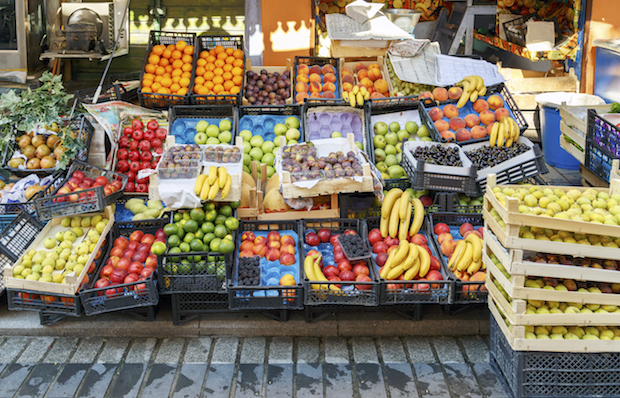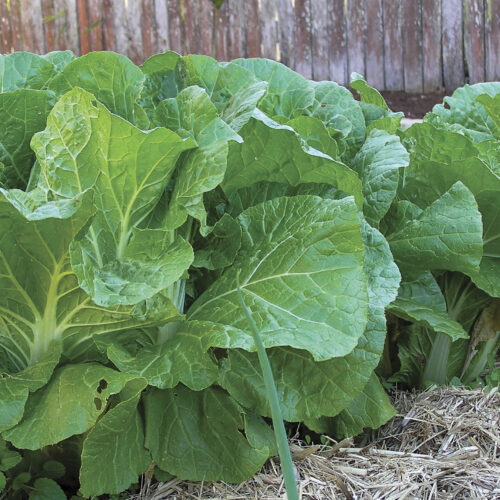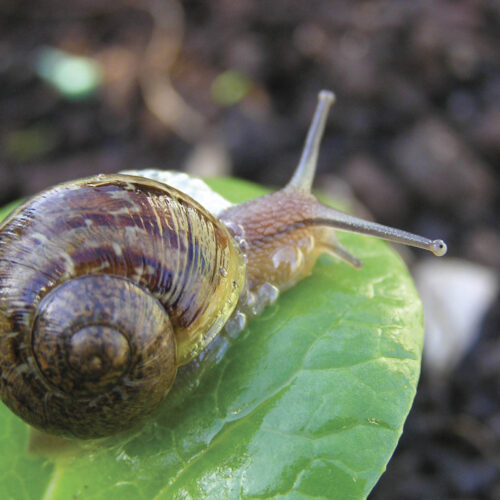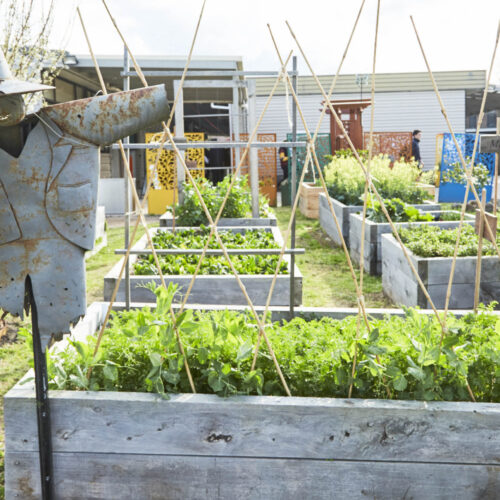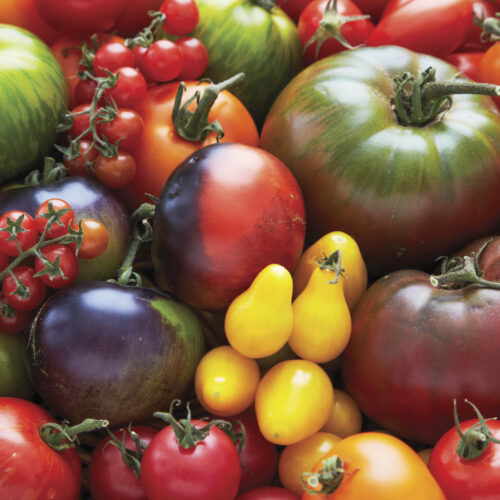What’s on my food?
2018-02-15T03:55:20+11:00
Malcolm McGuire investigates what’s being sprayed on our crops, and some of the worst offenders.
Until about 60 years ago the fruit and vegetables we bought over the counter were chosen for us by our local greengrocer or storeowner. Shoppers who asked for a ‘half pound of tomatoes’ were handed a paper bag with items at the top tending to be better than those at the bottom. Any bad bits, we cut out and composted, while vowing to let our grocer know.
By the mid 1950s Coles and Woolworths, which by then had been in operation with counter sales for many years, began converting their stores to self-service. ‘Shop as
you please, pay as you leave’ proudly bannered the Coles advertising. Australians warmly embraced this new concept and our shopping habits were changed forever.
Naturally, given the choice, shoppers reached for the best-looking fruit and vegetables and any odd-shaped or blemished items were left, resulting in a lot of waste. It wasn’t long before the supermarkets rejected anything from growers that didn’t ‘look’ perfect – a huge problem we still haven’t found a good answer to today.
This trend coincided with the burgeoning production of new agricultural pesticides, mostly from American and German chemical companies, that promised faster and greater yields with less damage from insect attacks. These first pesticides were developed from some of the same Allied and German operations that produced chemical weapons during the war – nerve gas agents are used to kill insects too.
To add to the equation, agriculture became increasingly industrialised and hands-off, with monoculture fields becoming the norm leading to a lack of diversity and increased pest pressure.
Pesticide used in agriculture
Pesticides are broadly divided into three categories – insecticides, herbicides and fungicides – for the control of insects, weeds and fungi respectively. There is nothing new in the use of organic preparations to control insects in food production; it dates back to ancient Greece and Rome. Rapid growth occurred in the number and complexity of the pesticides used in the period between the two world wars.
Among the worst chemicals are the systemic insecticides, which work by being drawn up into the plant by its leaves and roots where they remain. Pests are killed when they suck
the sap of the plant containing the poison. As the insecticide remains stored inside the whole plant and not just on the skin – peeling, washing or cooking will not remove it. A particular case in point – produce that travels from Queensland to other parts of Australia (mangoes, tomatoes) is required (by government regulations) to be treated postharvest, before dispatch, with a systemic insecticide-based dip to prevent the spread of Queensland fruit fly. The majority of Australia’s winter tomato crop comes from the Bowen area in Queensland.
By law, all agricultural chemical products sold in Australia must be officially registered for use by the Australian Pesticides and Veterinary Medicines Authority (APVMA).
All registered pesticides must carry prescribed labels that show information such as the nature and content of the product’s active constituents, directions for use and handling information and its specific purpose, such as the name of the relevant pests and crops. It is illegal to use a pesticide for any purpose not specified on the label or the package in which the pesticide is sold, unless an authorised permit is made available by the APVMA. Pesticide registration is on a state-by-state basis; products may be permitted for use in some Australian states and not others. Situations often arise where chemicals are needed for a use not specified on the label, these are termed ‘off-label’ uses. (For more information and a complete list of APVMA-approved chemicals and their permitted uses visit apvma.gov.au)
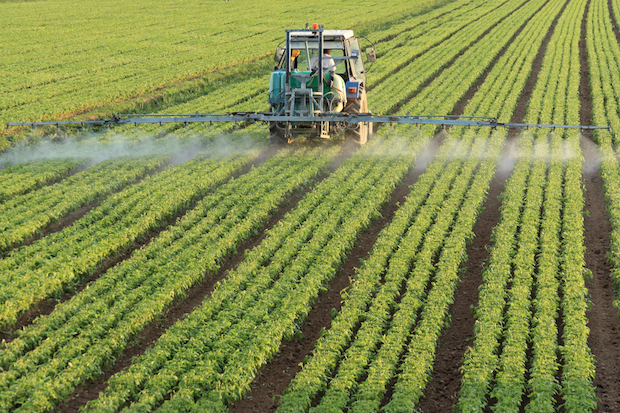
Monitoring of pesticide levels in food
While the APVMA has to be satisfied that individual pesticides are safe to use, it is not involved in the monitoring of pesticide levels in food.* In Australia, there is little coordination at a national level with various organisations taking the responsibility for monitoring. There is a National Residue Survey (agriculture.gov.au/ag-farm-food/food/nrs), a program conducted by the Department of Agriculture and Water Resources; and funded mainly by industry, which carries out random checks on pesticide levels, and the Australian Total Diet Study carried out by FSANZ.
Residue testing is totally dependent on the information provided to the APVMA by the chemical companies as neither the APVMA nor other government bodies do any testing themselves but, instead, they examine the data provided by the applicant and decide whether a particular pesticide has the capacity for harm in the amounts likely to be present in food. Testing does not account for the possible health risks of the ‘cocktail effect’ of several different pesticides used on the same crop or the possibility of accumulation in the body with repeated use over time. The approval given by the APVMA relates to the specific use of a particular pesticide on one occasion. The process also requires monitoring to be carried out on a regular basis by Commonwealth and State bodies, and by industry but only a very small proportion of food or crops are subjected to any form of chemical scrutiny. The process is completely random and depends very much on the results obtained from these random samples accurately reflecting the overall picture.
The worst offenders
Although we might be growing our own vegies and fruit, or buying organic from farmers markets and supermarkets, many of us will at times find ourselves purchasing non- organic produce. And for those that don’t have a garden space or big budget, this may not be a choice.
So what are the worst offenders to avoid if you do have to target your purchases?
Many people have heard of the US EWG’s Shopper’s Guide to Pesticides ‘Dirty Dozen’, which lists those foods most contaminated with chemicals. While this is a useful resource for Australian consumers, with haphazard testing, different pests and approved pesticides used in this country it cannot be relied on entirely. In February 2012, Friends of the Earth published ‘The Dose Makes the Poison?’, which attempted to identify those foods in Australia that had the most pesticide detections and the list was similar to the EWG’s. Apples, strawberries, pears, grapes, lettuce, nectarines and peaches were said to be the worst offenders.
Here are some of the specifics of the chemicals used and why.
Sunblock on your apples
Conventional apples reign supreme when it comes to pesticide load and over 1500 synthetic chemicals have been approved for use on them. There are many risk factors for apple growers, including insect problems (aphid and spider mite), fungal diseases and even fruit sunburn. As a defence against apple scab, apple trees are frequently doused with a range of powerful fungicides as a preventative measure pre- and post-harvest to ensure disease spores lodging on these parts are killed before they can establish an infection. In periods of wet weather, this can occur every 2–3 days.
In some orchards, apple scab fungus has developed a resistance to some fungicides, therefore a number of different fungicides are often used at the same time.
Sunburn, where strong ultraviolet (UV) light causes harmless but unsightly blemishes on parts of the apple’s skin, is a huge problem for apple growers and can affect a large part of the crop. Some protectants contain morpholine, a petroleum-derived synthetic chemical emulsifier, which has been identified as a precursor of N-nitrosomorpholine, a known carcinogen. Morpholine has been banned for use in food-waxing products in the European Union but despite this it is still allowed to be used by conventional fruit growers
in Australia. Before fruit can be sprayed with apple sunburn protectant, it must be ‘primed’ with a water softener containing tetrasodium EDTA, a preservative that’s made from formaldehyde and sodium cyanide.
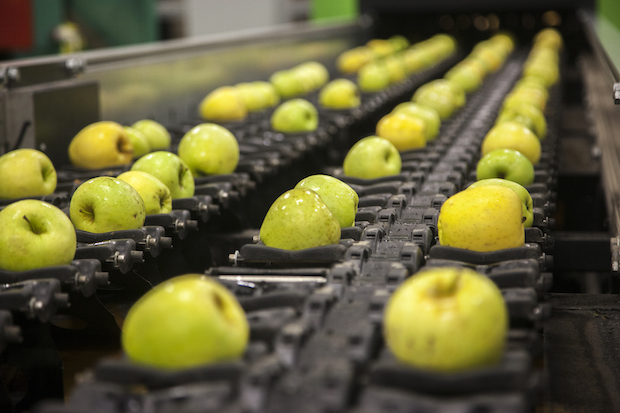
Banned chemicals on your pome
The codling moth is considered the most damaging pest of both apples and pears in Australia and a number of chemicals are registered for use in controlling it. These include; Fenoxycarb, a possible liver, thyroid and kidney toxicant and endocrine disrupter; Thiacloprid, a possible liver and thyroid toxicant and Parathion-methyl and Azinphos-methyl. These two chemicals are both highly toxic neurotoxins and have been banned in countries around the world including those in the European Union. Although they have both been under review for more than 20 years, they are still used widely in Australian orchards.
The citrus dip
Soon after harvest, oranges and other citrus are dipped in a fungicide to prevent blue and green mould. As this wears off, several additional applications of fungicide are applied to the fruit. After fungicide is applied, the oranges are sprayed with wax, which is then baked on to the fruit. Bulk oranges are also sprayed with an insecticide if fruit fly are present. Methyl bromide is also often used for fumigation.
There’s a pesticide for birds?
Several species of birds can cause severe damage to ripening grapes. When netting isn’t an option, to protect against bird strike, grape and other fruit growers often turn to chemical repellents such as methyl anthranilate. While the chemical smells like grapes, it has a taste that birds can’t stand.
The repellent, which doesn’t wash off, dissipates two weeks after application, so fortnightly spraying is necessary for it to work.
Tear-gassed carrots
The liquid fungicide chloropicrin is injected into the soil and immediately converts to a gas, fumigating the carrots as it is released. Chloropicrin was used as tear gas by German forces in World War I.
Potato blitz
Conventional potato growers have at their disposal an army of broad-spectrum pesticides to kill pests such as late blight, the disease that caused the Irish Potato Famine. More than 1800 government-approved pesticide products are available for use on potatoes – more than for any other fruit or vegetable crop. Among these is atrazine, which is banned in the EU.
Not so peachy
The soft flesh of peaches makes them an easy target for insect pests and there are more than 1000 different pesticide products registered for use on the fruit in Australia. Each one is designed to target a different pest species and many are used simultaneously. An example is carbaryl, which is approved for use in Australia on peaches and some fruits and vegetables but has been classed as a possible human carcinogen and withdrawn in the UK and other European countries.
Bleached garlic anyone?
At a fraction of the price of the locally produced crop, it may be tempting to buy the cheap bags of Chinese garlic available in supermarkets. Producing around 500,000 tonnes a year, China is by far the largest supplier of garlic in the world. With no trade barriers, Australia imports over 80 per cent of its garlic from China, Mexico, Argentina, US and Spain. Chinese garlic can be bleached with chlorine to give it a white appearance; gamma irradiated to prevent sprouting; and sprayed with maleic hydrazide to extend shelf life – at certain times of year it’s likely that imported garlic, on sale in supermarkets today is last year’s crop. Chemicals banned in Australia are still being used on garlic in China and some other countries. Also, all imported garlic is fumigated with the toxic biocide methyl bromide by AQIS on arrival here.
Better choices
Produce with thicker skins that needs peeling and which is less reliant on systemic pesticides is a better choice when organic isn’t available. These include avocadoes, mangoes, onions, pineapples, sweetcorn, melons and kiwifruit. There are no synthetic pesticides approved for use on basil, sage, thyme, parsley or chive crops in Australia. But note: Dried herbs and spices imported into Australia are irradiated.
*Although the APVMA does not do the testing, it does set the minimum residue limits (MRLs) allowable on food for agricultural and veterinary chemicals registered for use in Australia. Government authorities say “these MRLs are set at levels that pose no risk to human health and are not likely to be exceeded if used in accordance with directions on the label.”
Malcolm McGuire is the author of YOUR FOOD – Where food comes from and how it is produced, an A–Z guide on the origins and production methods used for our major fresh food items including fruits, vegetables, dairy, meat, eggs and seafood. More info: yourfoodcommunity.com

